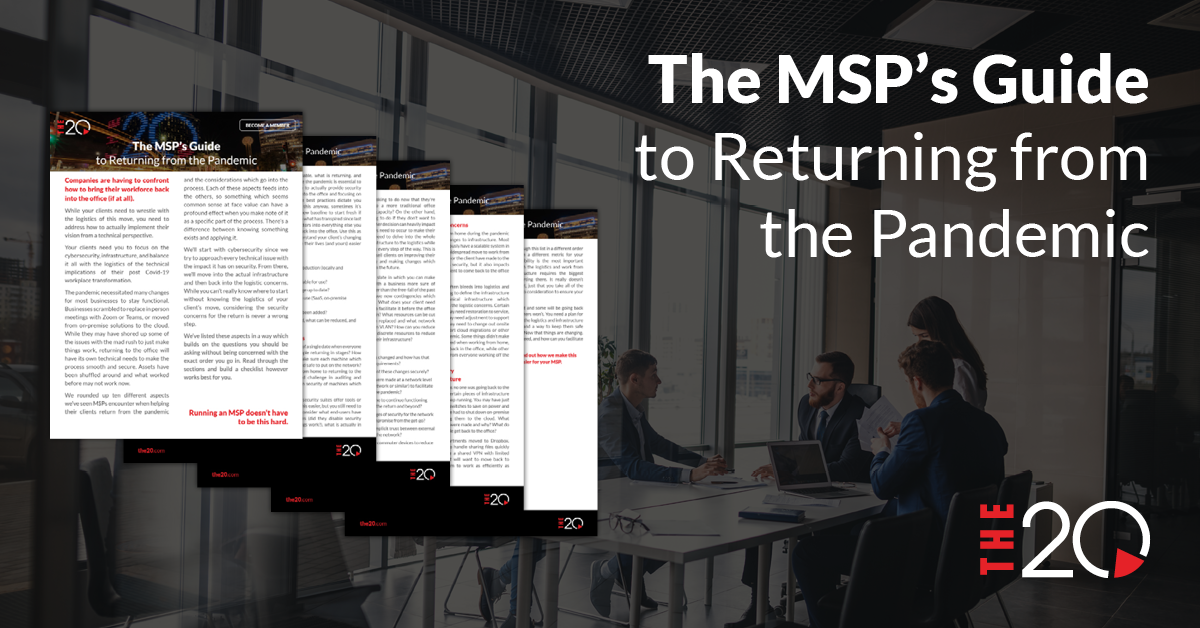Companies are having to confront how to bring their workforce back into the office (if at all). While your clients need to wrestle with the logistics of this move, you need to address how to actually implement their vision from a technical perspective. Your clients need you to focus on the cybersecurity, infrastructure, and balance it all with the logistics of the technical implications of their post Covid-19 workplace transformation.
The pandemic necessitated many changes for most businesses to stay functional. Businesses scrambled to replace in person meetings with Zoom or Teams, or moved from on-premise solutions to the cloud. While they may have shored up some of the issues with the mad rush to just make things work, returning to the office will have its own technical needs to make the process smooth and secure. Assets have been shuffled around and what worked before may not work now.
We rounded up ten different aspects we’ve seen MSPs encounter when helping their clients return from the pandemic and the considerations which go into the process. Each of these aspects feeds into the others, so something which seems common sense at face value can have a profound effect when you make note of it as a specific part of the process.
We’ll start with the basics of cybersecurity, infrastructure, and the logistic concerns. Sign up for the full version of this article which includes the actual 10 most common aspects we have seen our partners deal with during this return and what to consider when working with them. There’s a difference between knowing something exists and applying it.
Cybersecurity Concerns
With the return to the office, there are going to be many new security concerns to square up. Devices have been effectively out in the wild for a year, needs in the office have changed, and you need to be aware of everything touching the network. This is something you normally keep up with in the regular scope of running your MSP, but it is exacerbated by the fragmented nature of work from home.
This section will cover the security concerns at a high level since there really isn’t a one size fits all approach to security. You need to audit assets in the office and beyond, audit devices coming in, make sure that the network makes sense for the new normal, and make sure that old methods of getting in are removed when they need to be. While each of these are straightforward enough in writing, there are multiple parts to consider. We start with security since you should always think about the security implications first (where possible).
Considerations:
What assets are in production (locally and remotely)?
What assets are available for use?
Is everything in storage up to date?
What solutions are in use (SaaS, on-premise solutions, etc.)?
What solutions have been added?
What can be removed, what can be reduced, and what is essential?
Infrastructure Concerns
The move to work from home during the pandemic necessitated many changes to infrastructure. Most businesses didn’t previously have a scalable system in place to facilitate the widespread move to work from home. The changes you or the client have made to the infrastructure impacts security, but it also impacts the logistics for your client to come back to the office to work as necessary.
While infrastructure often bleeds into logistics and vice versa, we are going to define the infrastructure as the actual technical infrastructure which transparently supports the logistic concerns. Certain onsite infrastructure may need restoration to service, other infrastructure may need adjustment to support safe habits, and you may need to change out onsite infrastructure to support cloud migrations or other changes from the pandemic. Some things didn’t make sense to have centralized when working from home, but can provide value back in the office, while other things will slow down from everyone working off the same connection.
Considerations:
How is your client returning and what do they need to stay safe?
How does this work with their expansion and growth?
Do they need more bandwidth, more flexibility, or both?
Logistic Concerns
While many clients are returning to their offices, the logistics of how they do business is probably going to change. Before the pandemic, if someone was sick or on vacation, they might have some way to do work, but there wasn’t often the need for a way to do their entire job remotely. You expected someone to be gone for a fixed amount of time, not potentially permanently while still working.
Your security policy for your client and even the exact specifications of infrastructure changes will depend on the logistics of how they do business. If they implemented a new cloud infrastructure, you may have the bandwidth exhausted or barely touched depending on how the business adapts to their return from the pandemic. The cat’s out of the bag with remote work as at least a potential option, and businesses are going to strike a balance. Logistic changes will mean new movement in and out of the office, and new long term plans for the new normal.
Considerations:
What changes is your client making and how can you facilitate them?
What changes have happened to your client’s business model and how do those impact logistics?
Why are they making certain choices and is there a better way?
Conclusion
There are so many other considerations we can dive into, but these 10 main points across 3 different levels of consideration should help you get deeper into the process. You may not be able to shore up every single consideration depending on the logistical constraints of your client, but you can make sure they know the limitations of what they’re doing and how it impacts their business. No decision will ever be perfect without unlimited resources or extreme luck, but you can make sure that every decision is the right one for you and your client.
This list isn’t exhaustive, but it should help you towards exhausting the considerations you need to have for helping your client. What other considerations can you think of and how does it fit in with everything else you’re doing? How can you turn your client’s vague idea into a tailored plan that covers their bases for their return from the pandemic? How do you make the process scalable between different clients without having to reinvent the wheel at each level?
It might help to go through this list in a different order as well to target from a different metric for your considerations. If flexibility is the most important requirement, start with the logistics and work from there. If the infrastructure requires the biggest changes, consider starting there. It really doesn’t matter where you start, just that you take all of the important elements into consideration to ensure your client’s success.
Every client is different and some will be going back into the office while others won’t. You need a plan for each client to facilitate the logistics and infrastructure behind their decision and a way to keep them safe every step of the way. Now that things are changing, what does your client need, and how can you facilitate it for them?
READ MORE: Check out our full 10-pg guide here!



